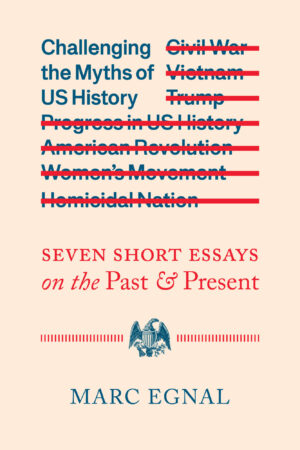How to Reexamine our Nation’s Past with a Critical Eye
By Marc Egnal, author of Challenging the Myths of US History: Seven Short Essays on the Past and Present
Challenging the Myths of US History offers a meditation on the soul of America. It explores the question: what narrative should we tell ourselves about the nation’s past?
The most popular story, one widely shared in textbooks and classrooms, takes its guidance from Lincoln’s remarks at Gettysburg. The Founding Fathers, the president told listeners, “brought forth, upon this continent, a new nation, conceived in liberty, and dedicated to the proposition that all men are created equal.” This account offers a clear vision of America, one with deep roots in the noble pronouncements of the Declaration of Independence. Lincoln framed the Civil War as a “new birth of freedom,” and concluded with praise for America’s democratic experiment and his hope that “that this government of the people, by the people, for the people, shall not perish from the earth.”
This uplifting narrative does not ignore problems but emphasizes America’s lofty values and progress. The journey it portrays has many way stations. They include the colonists’ clarion call for liberty; emancipation and the reaffirmation of national unity that emerged from the Civil War; the advances, if short-lived, of Reconstruction; the reforms of the Progressive Era; the enfranchisement of women; FDR’s New Deal; the Civil Rights movement; LBJ’s Great Society; Obama’s election; and, more recently, marriage equality.
What narrative should we tell ourselves about the nation’s past?
As for foreign policy, while acknowledging stumbles, this familiar retelling suggests the US has been a force for good. In World War I the nation fought to “make the world safe for democracy,”’ while in World War II it became the “arsenal of democracy.” The Marshall Plan restored Europe; the peace corps and foreign aid reflect American idealism, as does the ouster of dictators like Saddam Hussein, Muammar Gaddafi, and Osama bin Laden.

In Challenging the Myths of US History, I present a very different narrative of American history. I argue the United States was guided from the start by upper-class expansionists set on economic and territorial growth. Instead of a nation “conceived in liberty,” the book depicts a country that since its earliest days had racism deeply embedded in its laws and practices. The book presents this case with seven essays that look at progress in the writing of US history, the American Revolution, the Civil War, the high level of homicides, the Vietnam War, the women’s movement, and Trump.
The work does not set forth a monolithic picture of the American past or dismiss the traditional narrative out of hand. Rather the story of America must be viewed like a symphony with the stringed instruments, the percussion and brass playing the dominant themes. Listeners can hear another melody, played by the woodwinds and the flutes. It’s there if you carefully listen for it.
For example, Lincoln’s nation “conceived in liberty” references that faint counterpoint, when in fact the Founders protected slavery and spurned the demands of women and, more broadly, the less wealthy. The commitment of the ruling elite to expansion, economic and territorial, was made clear in wars against Native people, the establishment of banks and other enterprises, new trade routes, and in the effort to conquer Canada.
Challenging the Myths of US History represents a lifetime of my work studying and writing on US history. The book will encourage readers to think more critically about our nation’s past.
